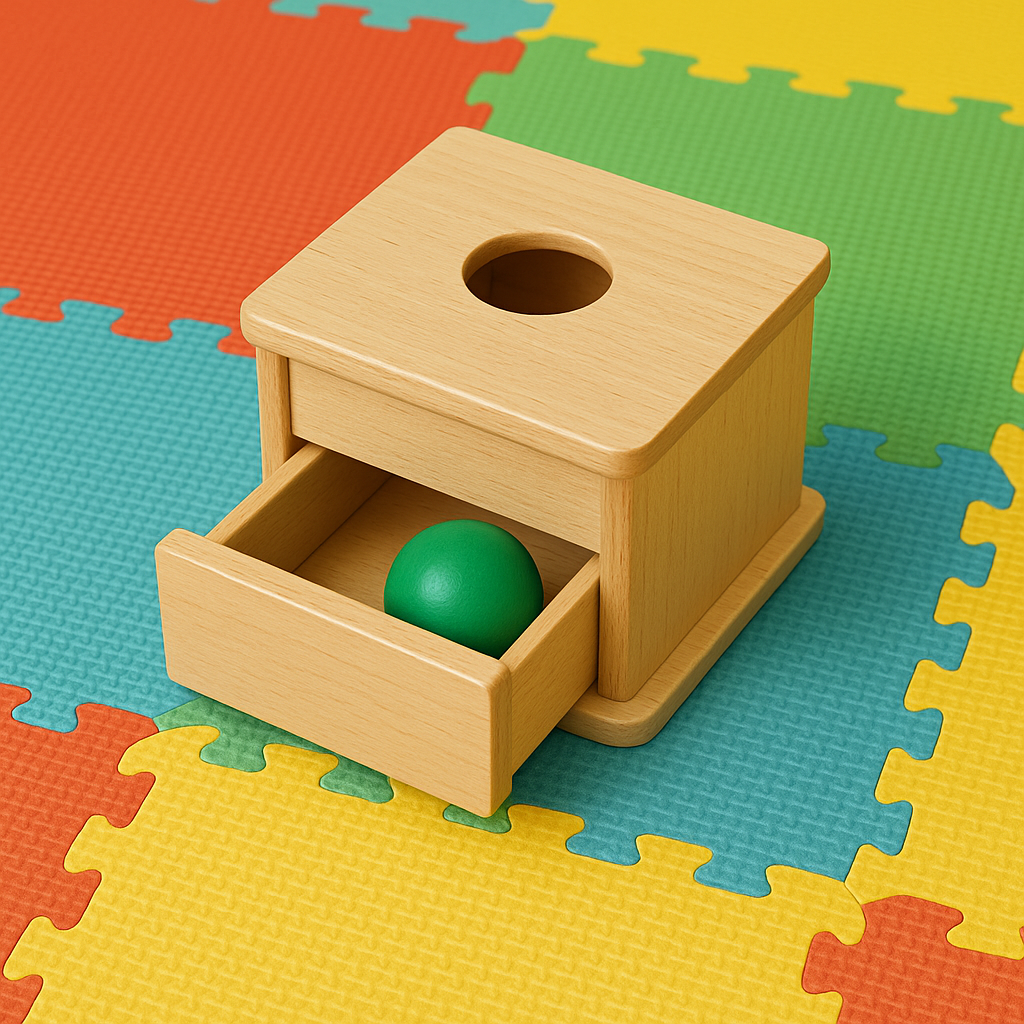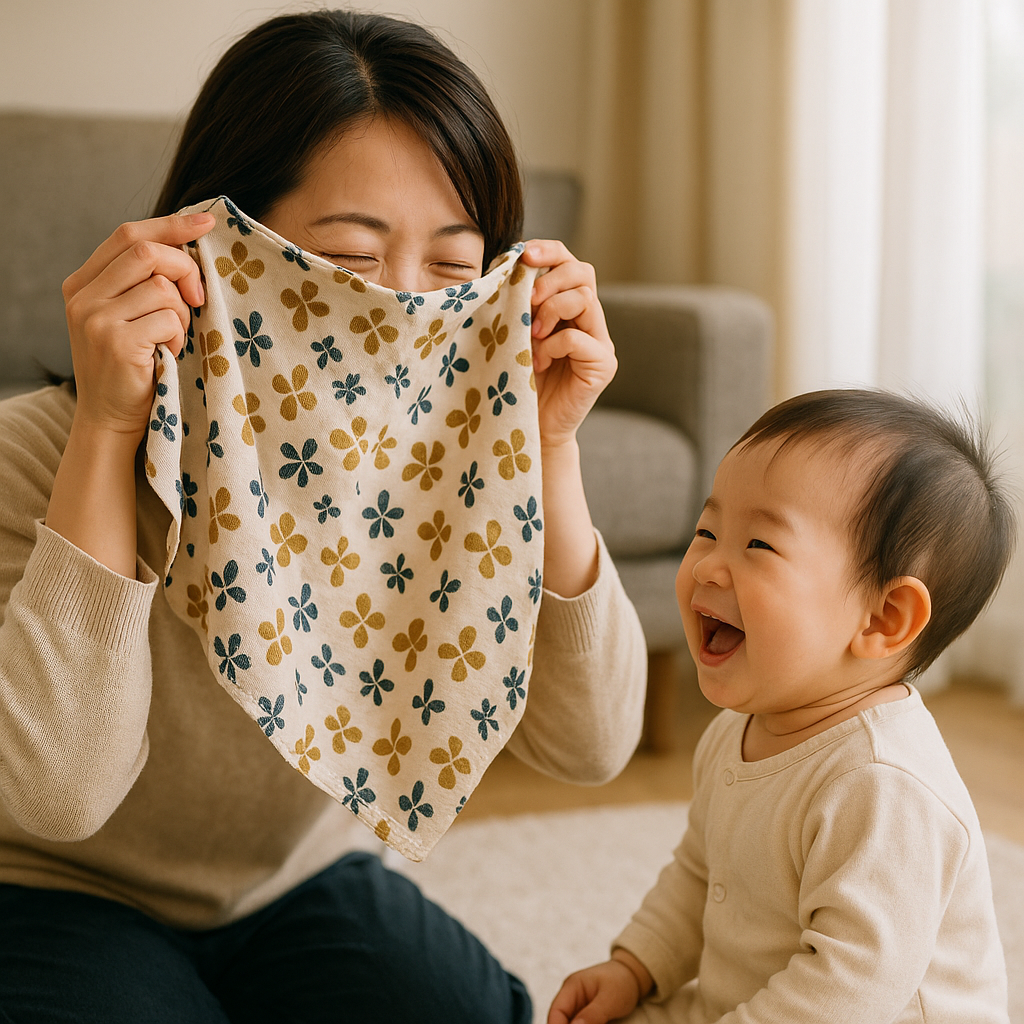Imagine your baby’s delight when you pop out from behind your hands with a cheerful “boo!” That giggle-filled moment is more than just fun—it’s your baby’s brain learning that people and things still exist even when they’re out of sight. Peek-a-boo is a powerful game that supports, language development, emotional security, and motor skills. This article explores the science behind peek-a-boo, how it evolves with your baby’s age, and practical tips to make it a brain-boosting staple in your daily routine.
- Why does peek-a-boo spark object permanence in the first place?
- When should you start playing peek-a-boo with your baby?
- How can you level-up peek-a-boo as your baby grows?
- Which other developmental skills bloom during peek-a-boo play?
- Can peek-a-boo ease—or trigger—separation anxiety?
- What if your baby doesn’t seem interested in peek-a-boo?
- Does digital peek-a-boo work as well as face-to-face play?
- How do different cultures play peek-a-boo-like games?
- What is the hard science behind those giggles?
- Quick-fire answers to parents’ top peek-a-boo questions
- Final thoughts
Why does peek-a-boo spark object permanence in the first place?
Peek-a-boo’s magic lies in its blend of surprise and predictability. When you hide your face, your baby holds a mental image of you, waiting for your return. This process builds the understanding that objects and people persist even when hidden.
During peek-a-boo:
- Visual and auditory cues (like your voice saying “boo!”) activate the prefrontal cortex, where working memory develops.
- Dopamine, a feel-good chemical, is released when your baby’s prediction of your return comes true, making the game rewarding.
- Repetition strengthens neural connections, solidifying the concept of permanence.
For more brain-boosting basics, visit Boost Your Baby’s Brain Power.

When should you start playing peek-a-boo with your baby?
You can start peek-a-boo from birth, as newborns love the sound of your voice and the sight of your face. While cognitive benefits kick in around 4 months, early play builds social bonds as per What to Expect. Here’s how your baby’s reactions evolve, based on developmental milestones:
| Stage | Typical Age | What You’ll See |
|---|---|---|
| Early curiosity | 0–3 months | Smiles or stills at your reappearing face |
| Emerging memory | 4–6 months | Eyes widen, anticipates your reveal |
| Partial search | 6–8 months | Lifts cloth or looks behind hands |
| Full retrieval | 9–12 months | Actively uncovers toys or crawls to find you |
Preemies or infants with motor delays often catch up once sitting improves, echoing the NIH study linking postural control to object permanence. Help that journey with daily Tummy Time Benefits.
How can you level-up peek-a-boo as your baby grows?
Keep peek-a-boo engaging by adapting it to your baby’s growing skills:
- Hands-Only: Hide your face with your hands, using an exaggerated “boo!” for newborns.
- Scarf Surprise: Drape a light scarf over your face for suspense (4–6 months).
- Blanket Cave: Cover both of you with a blanket for tactile fun (6–8 months).
- Find the Toy: Hide a rattle under a cup and let your baby uncover it (9–12 months).
- Object Permanence Box: Use a Montessori-style box where a ball disappears and reappears (12+ months).
Add sensory elements like shaking a rattle before hiding it (sound), using a textured cloth (touch), or shine a flashlight behind the blanket (light). Encourage baby-led hiding to build agency and motor planning. Find simple build-it-yourself versions in DIY Baby Toys: Budget-Friendly Brain Boosters.

Which other developmental skills bloom during peek-a-boo play?
Peek-a-boo is a developmental multi-tool, supporting:
- Language Development: Phrases like “Where’s Mommy?” teach turn-taking, a foundation for conversation as per BBC Tiny Happy People.
- Emotional Security: Your predictable return reduces stress hormones, fostering trust and attachment.
- Motor Skills: Reaching for a blanket or crawling to find you strengthens coordination.
- Cross-Modal Integration: Combining visual (your face) and auditory (your voice) cues activates mirror neurons, enhancing sensory processing.
Compare these benefits with rhythm-based learning in Music for Babies.
Can peek-a-boo ease—or trigger—separation anxiety?
Yes, but it can also trigger it. Around 7–10 months, babies realize you exist when out of sight, which can lead to. Peek-a-boo helps by reinforcing that you’ll return. Try these steps:
- Use a consistent phrase like “I’ll be right back!”
- Hide briefly behind a door (5 seconds), then reappear with a smile.
- Gradually increase the time you’re hidden to build confidence.
Consistency is key, as studies show babies prefer predictable patterns in play.
What if your baby doesn’t seem interested in peek-a-boo?
If your baby seems uninterested, it’s likely about timing or stimulation. Try these:
- Play when your baby is alert, not tired or hungry.
- Shorten the hide to 1 second for sensitive babies.
- Use a favorite toy as the “hider” instead of your face.
- For low-vision babies, use high-contrast or or a soft-textured scarf for visually impaired infants. See High-Contrast Books for extra ideas).
Consult a pediatrician if your baby shows no social smile by 3 months or no object search by 12 months.
Does digital peek-a-boo work as well as face-to-face play?
Face-to-face peek-a-boo is more effective than digital versions. Research suggests in-person play engages babies longer due to real-time social cues like scent and micro-expression. Video-chat peek-a-boo with relatives can be a fun supplement but shouldn’t replace live interaction. For more on screen time, see Play vs. TV.
How do different cultures play peek-a-boo-like games?
Peek-a-boo-like games are universal, reflecting their role in human development:
- Spain: “¡Cucú-tras!” with playful gestures.
- Japan: “Inai-nai-ba” with musical tones.
- Nigeria (Yoruba): “Bo-ju,” often sung rhythmically.
Local tunes add rhythm and prosody that boost early language mapping, underscoring an evolutionary role in social cognition.

What is the hard science behind those giggles?
Studies using functional near-infrared spectroscopy (fNIRS) show that peek-a-boo activates the prefrontal cortex, linking surprise to cognitive growth. See Infant Brain Responses. The game’s repetition strengthens neural pathways during the critical 0–24-month period when the brain prunes unused connections. For more science-backed play ideas, visit Fun Activities to Boost Baby Brain Development.
Quick-fire answers to parents’ top peek-a-boo questions
-
At what age does object permanence fully solidify?
Bold answer: Most babies master it between 9–12 months, though signs emerge as early as 5 months. -
Can too much peek-a-boo overstimulate my baby?
Bold answer: Watch cues—five to ten short rounds per session are plenty. -
Do I need fancy toys?
Bold answer: No. Your expressive face is the ultimate learning tool, but an Object Permanence Box offers fun variety. -
Does peek-a-boo help future math skills?
Bold answer: Yes. Holding a mental representation of hidden objects is the foundation for symbolic reasoning used in math.
Final thoughts
Peek-a-boo turns giggles into neural architecture, weaving memory, language, motor skill, and emotional security into your baby’s first year. Keep hiding, keep revealing, and watch curiosity blossom—no pricey gadgets required, just your loving face ready to say “boo!” For more playful inspiration, explore 10 Sensory Play Ideas to Spark Your Baby’s Brain.